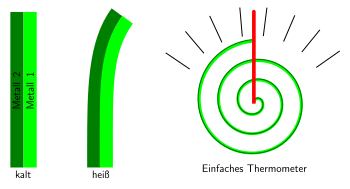Bimetal thermometer
Bimetal thermometers are thermometers that are based on the different thermal expansion of two connected metals, the so-called bimetal . The bimetal consists of two metal strips firmly connected to one another, each with a different coefficient of thermal expansion . When the temperature changes , the two metals expand to different degrees and thus cause the bimetal to bend.
General
With the thermometer , the temperature is then read from the strength of the curvature or the resulting angle on a scale . It is also possible to trigger a function at a certain temperature; this function is used, for example, for temperature switches in refrigerators , irons , hotplates and draft regulators on long-burning stoves.
Due to the purely mechanical way of working, you have to accept large tolerances (up to 10%), but the thermometer is easy and inexpensive to manufacture.
The temperature-sensitive sensor element of a bimetal thermometer is a bimetal strip designed as a spiral spring. A change in temperature is converted into a change in the angle of rotation by the bimetal spring firmly clamped on one side. The simplest thermometer designs only consist of a spiral spring with a pointer shaft, at the end of which a pointer is attached. The temperature reading can be read off the graduations on the thermometer dial.
The temperature range of bimetal thermometers is between −80 ° C and +550 ° C. The preferred application range is from −50 ° C to about 400 ° C. This also results in the frequent use of this type of thermometer in refrigerators or as an oven thermometer .
Industrial bimetal thermometers
If the measuring and display parts are spatially separated, a creeping, helically wound bimetal strip is housed in a longer immersion or protective tube . The temperature-dependent rotation is transmitted via a shaft to the pointer, which is located in a housing part at the upper end of the immersion tube. If the pointer shaft is in a radial position in relation to the thermometer housing, the rotary movement is transmitted to the pointer with low friction by a deflection spring or an angular mechanism and is thus shown on the display.
used material
Layered composite materials according to DIN 1715, so-called thermal bimetals, are used as the base material for the coils or helical springs. They consist of two roughly equally thick metal layers (components) of different thermal expansion that are inseparably connected to one another by means of a welding process ( plating ). The material components are selected in such a way that the greatest possible difference in the coefficients of thermal expansion results.
The component with the larger coefficient of thermal expansion, which is typically above 15 · 10 −6 K −1 , is often referred to as the "active" component of the bimetal. In most cases it consists of an alloy that contains iron , nickel , manganese or chromium in various compositions.
An iron-nickel alloy with 36% nickel (Invar) is often used as the “passive” component with the smaller coefficient of expansion below 5 · 10 −6 K −1 . This inexpensive material has a very small expansion coefficient of 1.2 · 10 −6 K −1 at room temperature (20 ° C) .
Under the influence of temperature, the bimetal strip bends towards the component with the lower coefficient of thermal expansion, i.e. towards the passive side.
Related embodiments
The different coefficients of thermal expansion of two materials can also be used to measure the temperature if they are not connected to one another over a large area by evaluating a difference in length. One of the partners can also be an existing construction part. Examples are the thermal switches in some irons, which use the base body made of cast aluminum as an “active” partner . Another example are the thermal switches of some boilers, which use the difference in length between the protective tube (copper) and a glass rod in it to measure the temperature.
literature
- Andreas Heintz: Thermodynamics: Fundamentals and Applications . 2nd Edition. Springer, 2017, ISBN 978-3-662-49922-1 , Chapter 3.7.21: The bimetal thermometer.

